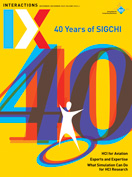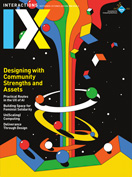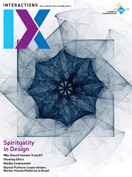Authors:
Susan Dray, Elizabeth Buie, Gillian Crampton Smith, Assem Kroma, Xiang Li, Aaron Marcus, Monica Pereira, Cuauhtémoc Rivera-Loaiza, Janice Rohn
Earlier this year, we issued an open call for stories about how SIGCHI has positively affected people; the response was quite good. Submissions came from a wide variety of people—an undergraduate who was just beginning their Ph.D. journey, a graduate student, an early-career professor, several senior researchers, and several "old-timers" who were present at the original Gaithersburg, Maryland, meeting in 1982, when SIGCHI was formed. They come from China, Canada, the U.K., Mexico, and the U.S., and from both academia and industry. This article summarizes some of the commonalities in these submissions. The complete pieces, as well as a Spanish-language version of one of them, will be published on the Interactions blog.
An open call for stories about how SIGCHI has positively affected people's lives surfaced five key themes:
→ SIGCHI is a welcoming community.
→ We are a community that cares about doing good.
→ SIGCHI has had a positive impact on people.
→ We are a diverse community.
→ Service is an important way to belong.
Some consistent themes arose, including the welcoming nature of SIGCHI, the diversity of the community, the way that we are a community that cares about doing good, the importance of service in becoming integrated into the community, and the important contributions that SIGCHI has made to individuals' lives.
Note: Many of the writers use CHI and SIGCHI almost interchangeably. This is a very common thing in our community, where the distinction between the CHI conference and the SIGCHI organization that supports it is not clear to many—even most—people.
 Theme 1: Sigchi is a Welcoming Community
Theme 1: Sigchi is a Welcoming Community
Virtually everyone commented on how SIGCHI welcomes people of all ages, stages, roles, and geographies:
- Xiang Li stated that, while an undergraduate, he "built connections with other Ph.D. students and senior academics" that have shaped his decisions about joining this field as an incoming Ph.D. student at the University of Cambridge.
- Third-year Ph.D. student Assem Kroma from Carleton University said, "There is no other group that welcomes people with creative and technical backgrounds alike, while allowing them to use their own frameworks within what's acceptable in the community."
- Early-career academic Monica Pereira wrote, "I am at home and in a supportive local and global community; that is SIGCHI."
- Seasoned academic Cuauhtémoc "Temo" Rivera-Loaiza described his experiences at CHI 1999, where he was a student volunteer: "From the first day of the congress I began to realize that this was definitely the field [in] which I wanted to make a career."
- Gillian Crampton Smith, a senior academic and recipient of the Lifetime Achievement in Practice Award, described her first encounters with SIGCHI at the CHI conference in 1990: "Everyone was very friendly but puzzled to meet a designer at CHI."
- Describing her first CHI conference in 1991, Janice Rohn, a senior person in industry, said, "What struck me at that first conference is that I knew that I was in the right field for me, because I immediately felt at home with this group of curious, groundbreaking, empathetic, and truly nice people."
- Senior consultant Elizabeth Buie, who began her career in the mid-1970s as a computer programmer, described her journey to HCI as sparked by the Gaithersburg conference, where SIGCHI was formed). She captured the intensity and excitement of the conference, saying, "Pow! The light bulb went on. I had signed up for the conference without a clue that HCI was even a thing, let alone a field of study."
- Another senior consultant, Aaron Marcus, was also at Gaithersburg: "We both [SIGCHI and Aaron's career] started 40 years ago." He described his interactions with people in the community as follows: "I certainly have learned from and benefited from the people I've met and the activities I've led or co-led…. My own understanding of the field of HCI and communication was both broadened and deepened."
 Theme 2: We are a Diverse Community
Theme 2: We are a Diverse Community
Another common theme was the diversity of the SIGCHI community:
- Assem Kroma said, "We are a group of engineers, cognitive scientists, computer scientists, ergonomists, user experience designers, and researchers. We follow different frameworks and approaches, yet it never divides us but rather unites us and gives us our unique impact on the society and community as one collective whole…. We are a true representation of what humanity is about. A beautiful mix of backgrounds and beliefs which don't cancel one another but rather complement each other. Having backgrounds in film, performance arts, engineering, and education made me a natural fit in such an interdisciplinary community of researchers."
- Temo Rivera-Loaiza pointed out that he had "learned, among many things, how diversity strengthens us all."
- Gillian Crampton Smith initially had to explain why she, a graphic designer teaching at an art and design graduate school (Royal College of Art in London), would "belong" at CHI—but rapidly found acceptance and became an important part of the community: "CHI enabled me and my students to learn from disciplines like engineering, psychology, anthropology, and business, which were not readily available in a design school, and exposed us to a broad range of value systems and worldviews."
- Even at her first CHI conference, Janice Rohn said, "I was immediately impressed by the breadth of topics and research covered in the conference, along with how accessible and friendly the attendees were."
- At Gaithersburg, Elizabeth Buie "was fascinated by the research that was being presented there, by all kinds of people I had never heard of."
- As a designer, Aaron Marcus was a pioneer in the SIGCHI community, and was the first graphic designer elected to the CHI Academy. He has also focused on bringing new voices to the SIGCHI community, such as science fiction writers (panel at CHI 1992).
 Theme 3: We are a Community that Cares About Doing Good
Theme 3: We are a Community that Cares About Doing Good
Most of the authors mentioned that the community really cares about doing good for others:
- Assem Kroma highlighted that "HCI research…guide(s) society to a better future."
- Monica Pereira pointed out that "all of the [SIGCHI] volunteers I have engaged with were very passionate about their role and were eager to assist others for the benefit of the community."
- Temo Rivera-Loaiza has shown through his career that "we all want and can contribute to improve our physical and digital environment."
- Gillian Crampton Smith talked about how her students, young designers, would give "guerrilla presentations of their work" through posters. "Indeed, one of the values of the presentation was its variety and its effect—a firework to spark the audience's imagination or a different slant on what they were working on themselves."
- Elizabeth Buie mentioned the improvements in her life and the lives of users that SIGCHI has sparked.
 Theme 4: Service is an Important Way to Belong
Theme 4: Service is an Important Way to Belong
Each of the authors mentioned service to SIGCHI as a way that they had these positive experiences:
- Xiang Li described his active volunteer roles in a variety of SIGCHI conferences as a key to his knowing what he wanted to do for graduate school, as well as where he met his future Ph.D. supervisor from the University of Cambridge. In addition, he served as the online participation cochair for DIS 2022, which gave him a deeper understanding of the task of organizing an academic conference.
- Monica Pereira noted, "While my experience with SIGCHI has been short, the nature of what SIGCHI stands for and those that affiliate themselves with the community have impacted my view on academia as a whole."
- Temo Rivera-Loaiza discussed how his role as a student volunteer gave him a quick introduction to the field that ultimately became his career. He was a founding member of the Mexican chapter of SIGCHI and has been instrumental in bringing speakers to the chapter. He points out that the Mexican HCI community has become a vibrant community supported by SIGCHI activities, especially conferences. Temo has continued to serve in many leadership roles, both within Mexico and in the broader SIGCHI community.
- Gillian Crampton Smith encouraged her students to become volunteers and to become part of the community through service.
- Janice Rohn described her service as usability cochair and management cochair when SIGCHI created communities, pointing out that her role has been, in part, "lending my industry perspective to the process."
- Elizabeth Buie, who went to graduate school later in life to earn a Ph.D. that she had always wanted, now works part-time for a UX agency "and spend[s] part of my free time continuing to be involved in SIGCHI." In addition to presenting her own research at CHI conferences, she has reviewed submissions, served as case studies cochair and industry liaison, and chaired workshops and SIGs. She edited The Whiteboard, a practitioner-oriented column in Interactions, for several years.
- Aaron Marcus served SIGCHI in a variety of ways, with a column, Fast Forward, in Interactions; chairing poster sessions at CHI 1987; and being a reviewer. Although not directly related to SIGCHI, he also served our sister organization, the User Experience Professionals Association as editor in chief of its magazine, User Experience.
 Theme 5: SIGCHI has had a (HUGE) Positive Impact on People
Theme 5: SIGCHI has had a (HUGE) Positive Impact on People
Authors were very enthusiastic about how SIGCHI has positively affected their lives:
- Xiang Li pointed out that "participating in and organizing activities under the SIGCHI umbrella [led me to] the idea of pursuing a Ph.D. in HCI…. I look forward to collaborating [with SIGCHI people] in the future."
- Assem Kroma said, "I look forward to the role of SIGCHI in the next era."
- Monica Pereira ended her essay with this: "SIGCHI has influenced my career choices and has shaped my long-term goals."
- Temo Rivera-Loaiza described his experiences at CHI 1999, where he was a student volunteer: "From the first day of the congress I began to realize that this was definitely the field [in] which I wanted to make a career." Also, "Being part of the SIGCHI community has helped me develop my potential as a researcher and teacher; I have learned about the importance of outreach…especially in areas of the world that have various economic and technological disadvantages." He titled his piece "On How Attending CHI Changed My Life."
- Gillian Crampton Smith attributed her experiences at CHI to helping her form "my long and happy collaboration with the U.S. computer world…. Such collaborations would not have happened without CHI, which stimulated a rich transatlantic exchange of people and ideas. This had a big impact for me." She ended her essay with this: "CHI allowed us to define our own discipline in a more rounded and more powerful way."
- Janice Rohn began her essay with "What can I say about an organization that helped to transform my life?" She said, "Many of these wonderful colleagues have become friends, and my life is forever transformed by their intelligence and friendship." She concluded with "CHI for me has been life-changing, and I don't even want to think about a universe in which I did not attend that fateful conference in 1991."
- Elizabeth Buie described one effect of the Gaithersburg conference in 1982 as "exciting! I finally knew what I wanted to do with my professional life…. Gaithersburg changed my life."
- The title of Aaron Marcus's essay, "How SIGCHI Changed My Life," was the inspiration for this article. Aaron began by saying, "SIGCHI changed the course of my professional career…. The events that SIGCHI nurtured and that I led benefited both SIGCHI/Interactions and my own professional expertise and experience." He ended as follows: "Over the past four decades, SIGCHI, CHI, and Interactions have each grown and developed into an ever stronger, more mature, more complex organization, event, and publication. In those years, my understanding of CHI's professionals and the discipline itself has developed far beyond my original conceptions of computers and human-computer interaction. We are both better for having been connected since our beginnings."
These authors, and others whose work is included or will be included in the Interactions blog, are a wonderful cross-section of SIGCHI members, yet they share some strikingly similar stories, and have described some very similar themes. This is quite encouraging, and reinforces the values of the community—inclusion, diversity, service, and positive impact on our profession and our world. SIGCHI's first 40 years have been enriched by our members. As Assem Kroma summed it up, "We look forward to a brighter [future] that is yet to come."
Susan Dray has played a major role in the development of HCI and SIGCHI. She is an ACM Fellow, an HFES Fellow, and a member of the CHI Academy and was awarded the SIGCHI Lifetime Achievement in Practice Award and UXPA's Lifetime Achievement Award. She is currently adjunct chair of partnerships for SIGCHI. [email protected]
Elizabeth Buie received her Ph.D. from Northumbria University on experiential techno-spirituality, for which she developed a grounded theory of transcendent user experiences. Her research includes the exploration and analysis of how the HCI community studies these experiences. She divides her time among research, user experience consulting, and singing Renaissance polyphony. [email protected]
Honorary Professor Fachhochschule Potsdam Gillian Crampton Smith founded interaction design programs at London's Royal College of Art, the Interaction Design Institute Ivrea, and Iuav University of Venice. Believing that design bridges culture and technology, her collaborations include ones with Apple Computer, Interval Research, IDEO, and MIT. She is a recipient of the SIGCHI Lifetime Achievement in Practice Award. [email protected]
Assem Kroma is a multiplatform storyteller, filmmaker, actor, researcher, and educator. His interdisciplinary research spans HCI, digital media, immersive storytelling and cinema. In his Ph.D. studies at Carleton University, he is focusing on attention-guidance techniques in extended reality and their interplay with cybersickness, presence, and user performance. [email protected]
Xiang Li is an incoming Ph.D. student in the Intelligent Interactive Systems Group at the University of Cambridge. His research interest lies at the intersection of mixed reality, bodily interfaces, and computational interaction. His research focuses on understanding the relationship between human bodies and the digital environment, and concurrently creating interactive systems. [email protected]
Aaron Marcus is an AIGA fellow; a member of the CHI Academy; a member of the ICOGRADA Graphic Design Hall of Fame; an ACM Distinguished Engineer; editor in chief emeritus of UXPA's User Experience magazine; editor of Information Design Journal; codirector and founder of the Design, User-Experience, and Usability conference; and author of 50 books and more than 300 articles. [email protected]
Monica Pereira is an early-career researcher and assistant professor in HCI at Brunel University London in the computer science department. As a chartered cyberpsychologist with the British Psychological Society, her interests lie in how we can use technology to improve human performance and understand human behavior. [email protected]
Cuauhtémoc Rivera-Loaiza is an associate professor at the Universidad Michoacana de San Nicolás de Hidalgo, in Morelia, Mexico. His professional interests are centered within the field of human-computer interaction, particularly in the design, implementation, and evaluation of Internet-based applications. [email protected]
Janice Rohn is a pioneer in the field of UX, beginning at Stanford and Apple, and establishing UX at multiple companies. She has been a contributor to SIGCHI and UXPA, has design patents, worked with former Vice President Al Gore's office, has taught more than 15,000 professionals, and leads the Intel Incubation process as head of CX. [email protected]
Copyright held by authors. Publication rights licensed to ACM.
The Digital Library is published by the Association for Computing Machinery. Copyright © 2022 ACM, Inc.






Post Comment
No Comments Found